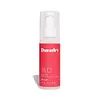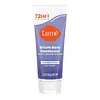What's inside
What's inside
 Key Ingredients
Key Ingredients

 Benefits
Benefits

 Concerns
Concerns

 Ingredients Side-by-side
Ingredients Side-by-side

Water
Skin ConditioningMandelic Acid
AntimicrobialMaranta Arundinacea Root Powder
Skin ConditioningTapioca Starch
Isoamyl Laurate
EmollientHydroxypropyl Starch Phosphate
Cetearyl Alcohol
EmollientCaffeine
Skin ConditioningCaprylic/Capric Triglyceride
MaskingBehenyl Alcohol
EmollientHydrogenated Castor Oil
EmollientParfum
MaskingAloe Barbadensis Leaf Juice
Skin ConditioningTheobroma Cacao Seed Butter
EmollientTocopherol
AntioxidantAllantoin
Skin ConditioningPanthenol
Skin ConditioningSandalore
Stearyl Alcohol
EmollientDimethicone
EmollientCetearyl Glucoside
EmulsifyingPentylene Glycol
Skin ConditioningPhenylpropanol
MaskingPotassium Hydroxide
BufferingDipropylene Glycol
HumectantSodium Benzoate
MaskingTetrasodium Glutamate Diacetate
Water, Mandelic Acid, Maranta Arundinacea Root Powder, Tapioca Starch, Isoamyl Laurate, Hydroxypropyl Starch Phosphate, Cetearyl Alcohol, Caffeine, Caprylic/Capric Triglyceride, Behenyl Alcohol, Hydrogenated Castor Oil, Parfum, Aloe Barbadensis Leaf Juice, Theobroma Cacao Seed Butter, Tocopherol, Allantoin, Panthenol, Sandalore, Stearyl Alcohol, Dimethicone, Cetearyl Glucoside, Pentylene Glycol, Phenylpropanol, Potassium Hydroxide, Dipropylene Glycol, Sodium Benzoate, Tetrasodium Glutamate Diacetate
 Reviews
Reviews

Ingredients Explained
These ingredients are found in both products.
Ingredients higher up in an ingredient list are typically present in a larger amount.
Water. It's the most common cosmetic ingredient of all. You'll usually see it at the top of ingredient lists, meaning that it makes up the largest part of the product.
So why is it so popular? Water most often acts as a solvent - this means that it helps dissolve other ingredients into the formulation.
You'll also recognize water as that liquid we all need to stay alive. If you see this, drink a glass of water. Stay hydrated!
Learn more about Water